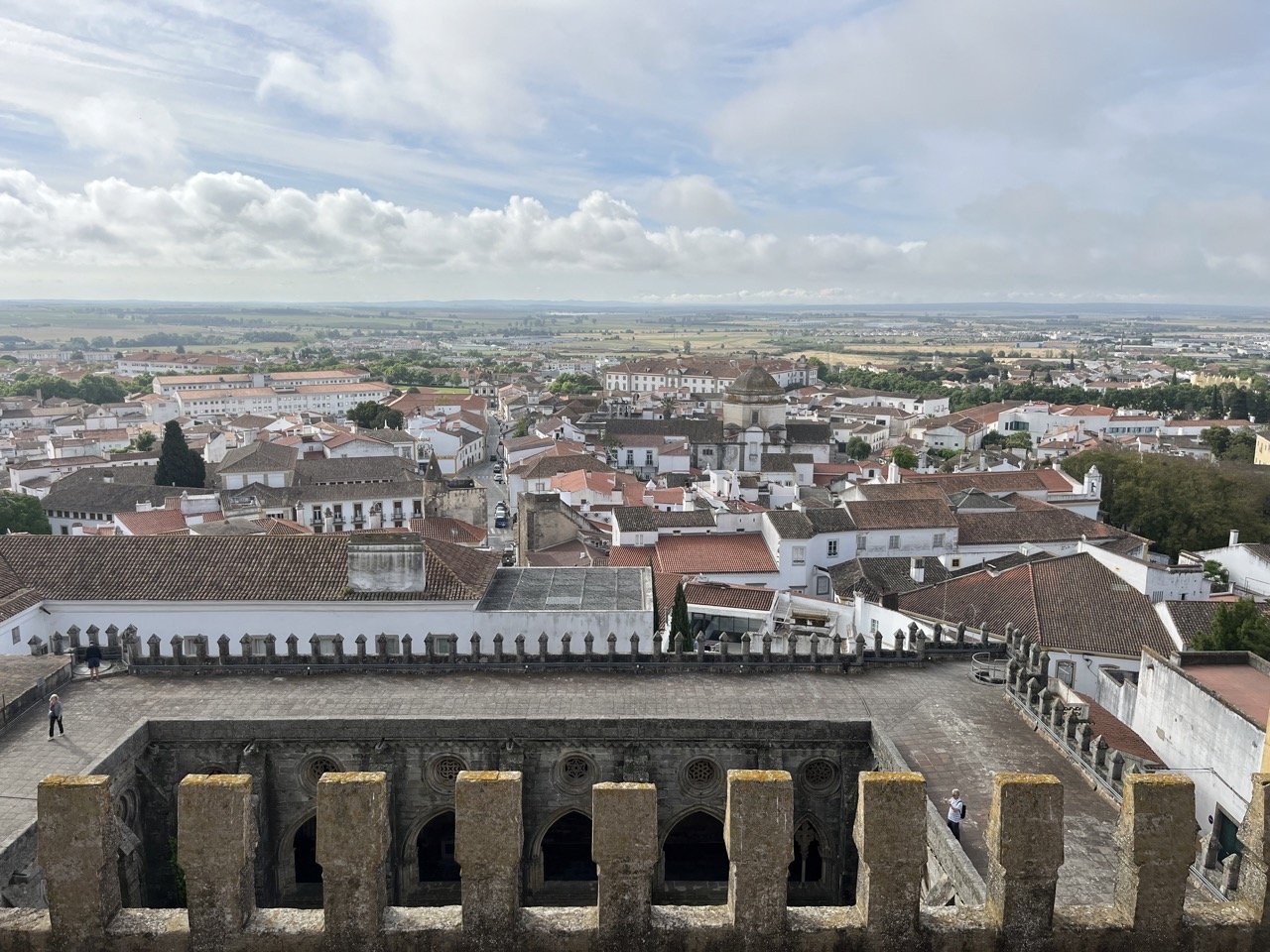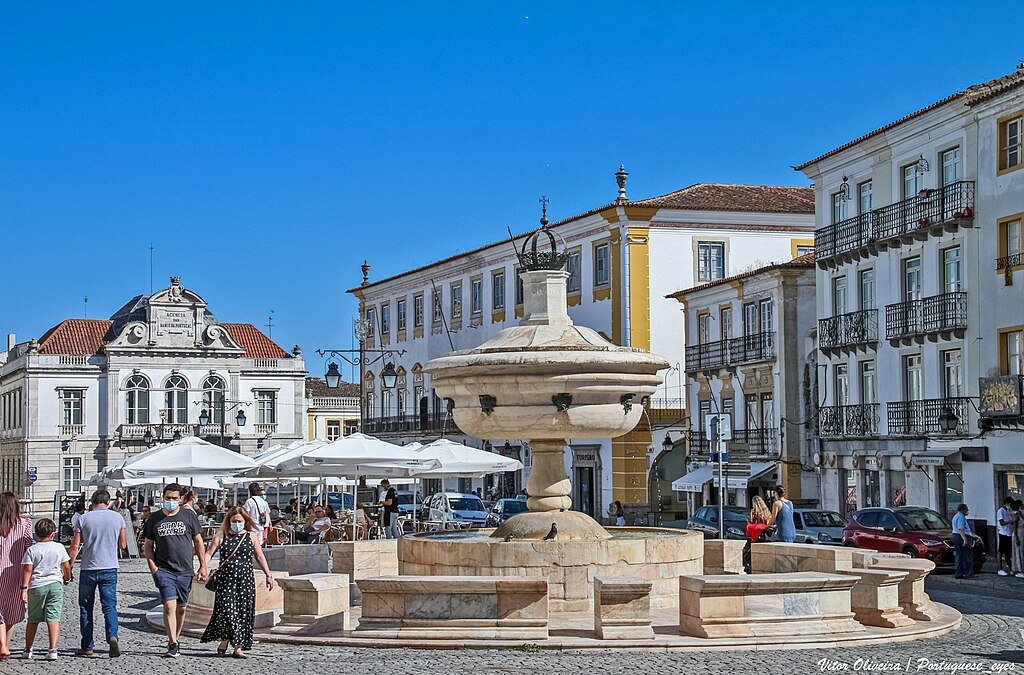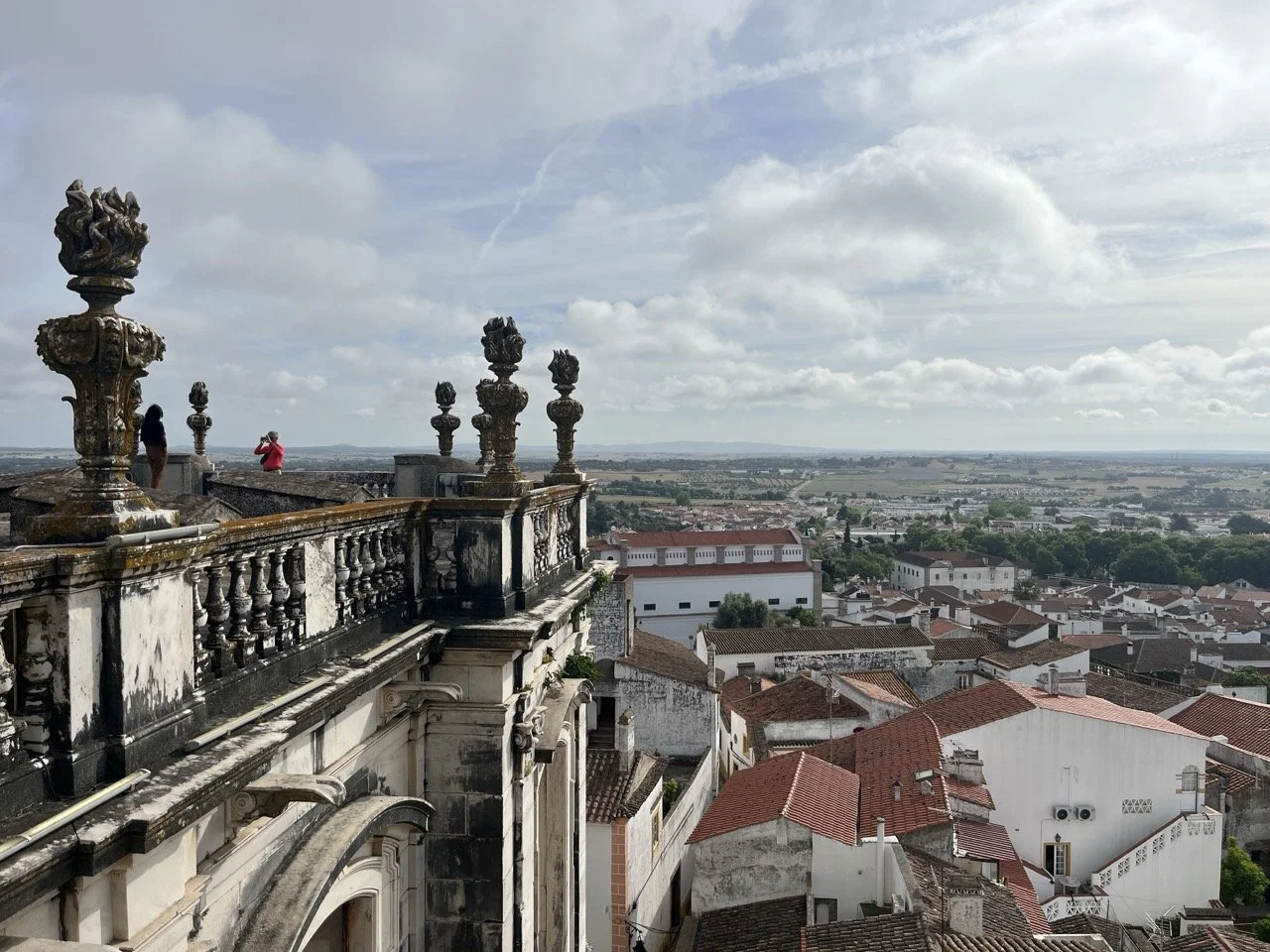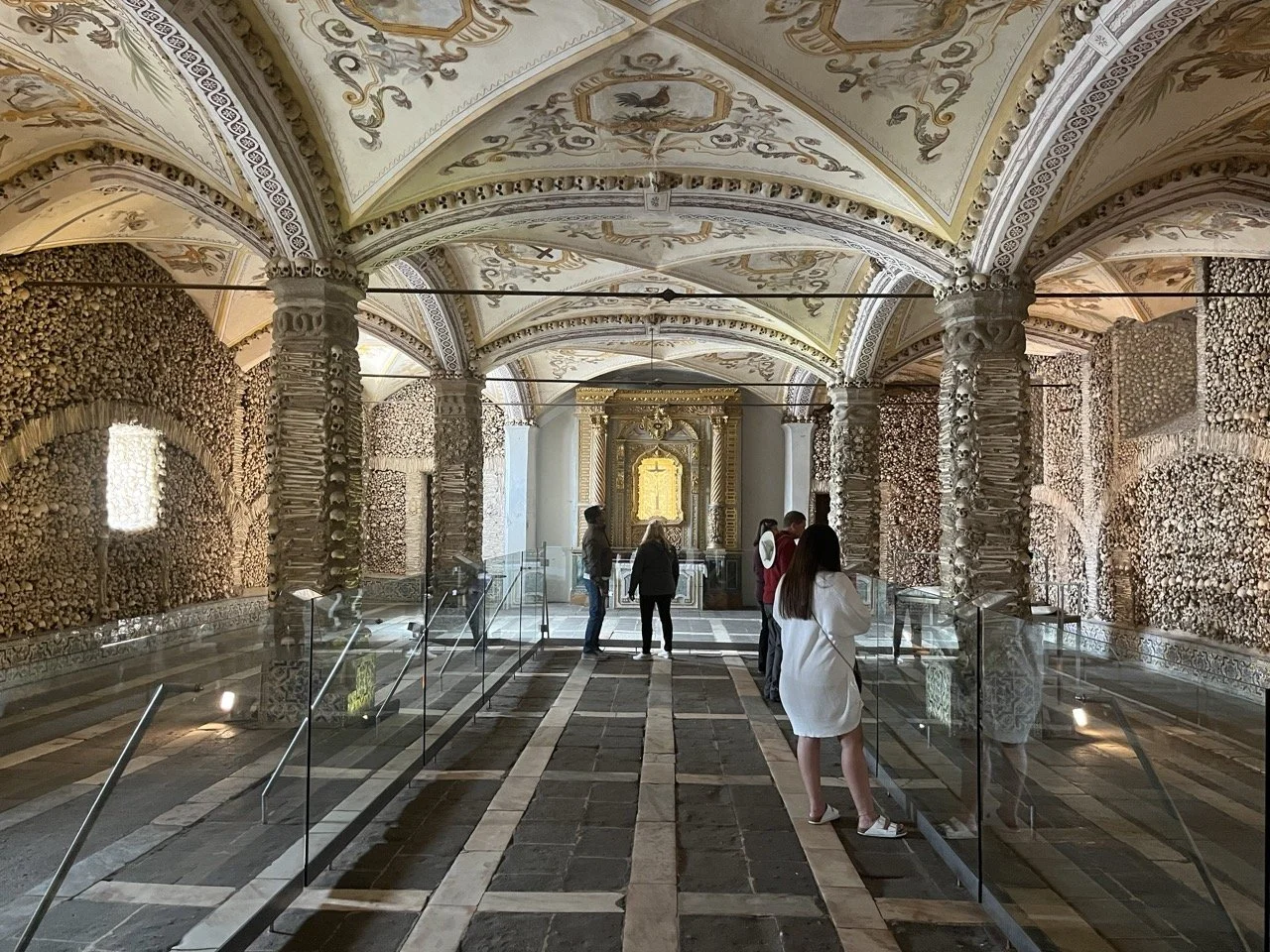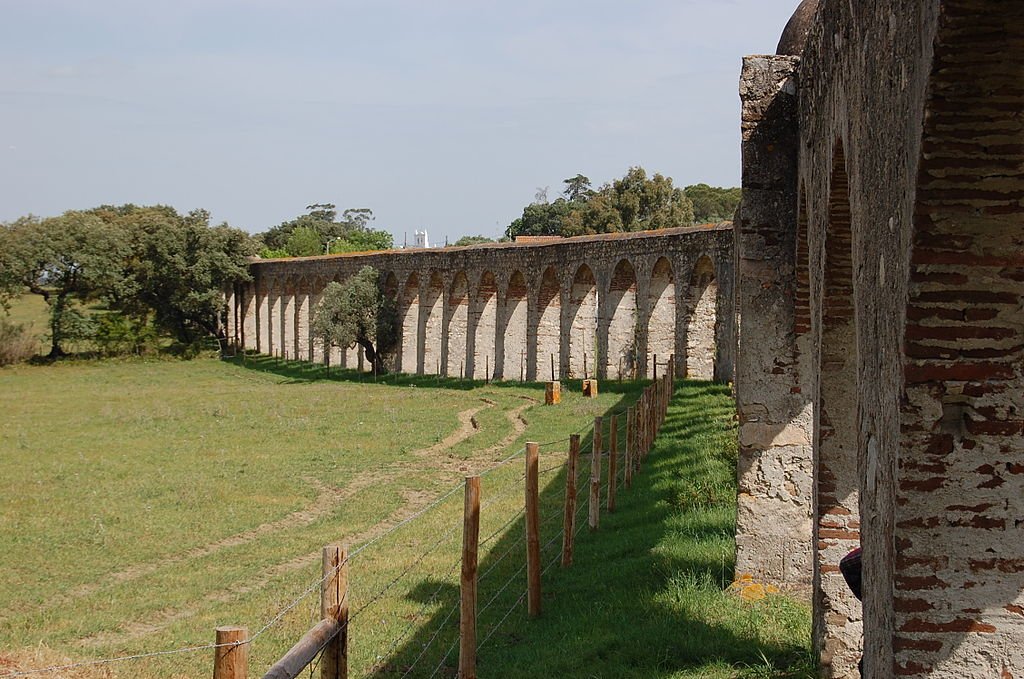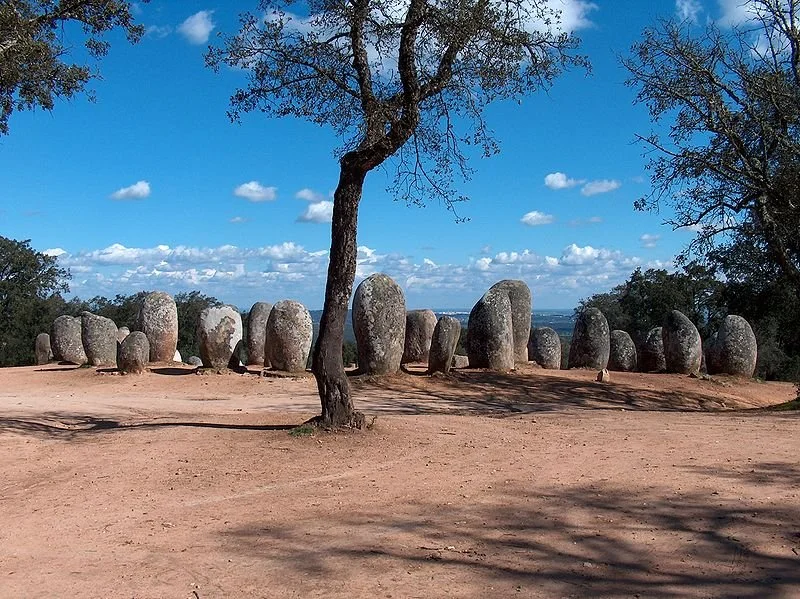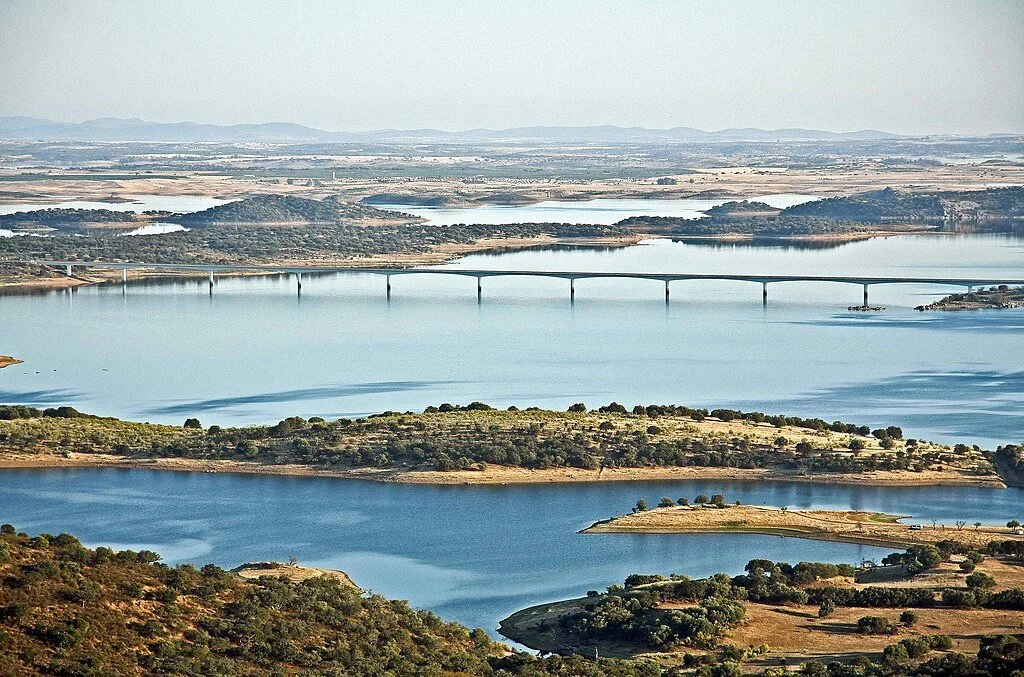A Local’s Guide to Évora, Portugal
Affiliate disclosure: some of the links in this article are affiliate links. If you book using one of them, we’ll earn a small commission. All of our info is free to read and free of ads, so we appreciate it!
Évora is a stunning UNESCO World Heritage city in central Alentejo, Portugal, famous for its beautiful architecture, friendly people, great wines, and the best comfort food. In Évora, you’ll find several reasons to stay indefinitely.
The first inhabitants arrived in Évora’s surroundings in 4000 B.C. Yet, it was the Eburones, a Celtic tribe, who founded the city in the 8th century. Since then, Romans, Visigoths, and Moorish made Évora their home. In 1165, Évora was recaptured during the Reconquista.
Over the millennia, all these people left behind an astounding heritage anyone can admire. From the Portuguese language to our culture and historical and architectural heritage, there is plenty for you to admire.
Here, you’ll also find the second oldest university in Portugal, headquartered in a stunning medieval building from the 16th century. While wandering the city, you’ll find students from all over.
But that’s not all! Évora is famous for its wines, cork production, olive groves, and a landscape of soothing rolling hills that’ll make you want to relax.
Table of Contents


Where is Évora
Évora is the capital city of the Alentejo region, and it lies inland from the coast, about 80 miles east of Lisbon. If driving, it will take about 2 hours to get here from the Portuguese capital.
The city has a population of a little over 50,000, which makes it the largest city in the region. However, this number fluctuates heavily throughout the year due to the large number of university students living here, who take off during school breaks (and even on weekends in many cases).
Located on a hilltop, Évora is surrounded by plains stretching out as far as the eye can see. The surrounding rural countryside offers a unique landscape of rolling hills with cork tree forests, olive groves, and vineyards. You’ll also find a few white-washed houses sprinkled here and there.
How to get here
The Alentejo is a rural region that is really best explored with your own car. However, being a major city that is fairly close to Lisbon, there are plenty of public transportation options for getting to Évora.
By bus
From Lisbon you have buses to Évora departing almost every hour, from early morning until into the evening. A one-way ticket costs around 5€. However, you should know bus tickets get more expensive (around 12€ per person, one way) over the weekends and holidays, as fewer buses run on these days. Purchase tickets via FlixBus or Rede Expressos.
From other towns in the Alentejo, you have buses run by the local company Rodoviária do Alentejo. This is the only bus company in the region that connects almost every town and small village with Évora (as well as many of them to one another).
You can buy the tickets at the bus station or directly from the driver once on board the bus. These buses don’t run nearly as frequently as others, but you’ll often still find at least a few journeys per day.
By train
From Lisbon's Sete Rios train station you have daily departures to Évora starting at 7:00 AM and continuing until around 8:00 PM. Train tickets are a bit more expensive than the bus, with prices between 13€ to 17€. Check the Comboios de Portugal website for timetables and ticket prices.
Driving
As I mentioned above, having a car in the Alentejo is highly desirable, and it will make your time here much more meaningful, as you’ll be able to get out all over the region, including to small towns, natural areas, and beaches.
If you’re coming from Porto, Lisbon, Faro, or any other larger coastal city in Portugal, you’ll have no problem finding a rental car. Roads in Portugal and the Alentejo are largely in excellent condition, traffic here is pretty minimal, and drivers are not overly aggressive.
If you plan on renting a car, I also always recommend checking prices on the car rental website DiscoverCars. You’ll find offerings from all the major international rental companies as well as lots of smaller local agencies, which often have much better pricing. You can often find great deals.
Taking a tour or private transfer
If you’d prefer not to drive but would like the freedom of having a car, a tour or private transfer is an excellent (albeit more costly) option.
It’s very common for travelers to head from Lisbon to the Algarve, first making a stop in Évora, or to do the reverse (going from the Algarve up to Lisbon, stopping in Évora along the way). With that in mind, there are many drivers and tour guides in Lisbon and Faro (in the Algarve) who offer this service as either an A-to-B transfer or as part of a guided tour.
Private transfers from Lisbon typically range between 200€ to 650€ one-way, whereas a transfer from the Algarve to Évora will cost between 400€ to 800€.
For an excellent tour from Lisbon, I always recommend local guide Ana Sofia, a licensed driver-guide who’s been leading tours to Évora and around Portugal for more than 20 years.
Why visit?
I lived in Évora while studying at university, so needless to say, it’s a city I cherish deeply and it’s somewhere I return to every chance I get! I’m sure once you visit, you’ll also fall in love with it.
For me, Évora offers the perfect blend of history, culture, and extraordinary cuisine. Pair all that with a glass of local red wine, and you’re in for a real treat.
Besides beautiful landmarks and incredible old buildings in the Old Town, you’ll also discover this is a place where you should slow down and simply enjoy the moment. You see, Évora has its own pace of life: although it’s the largest city in the Alentejo region, locals here take go about their daily lives leisurely, and they invite visitors to do the same.
A historic city, visitors can also explore unique historical monuments, such as the Cromeleques dos Almendres, the Roman Temple, and the largest medieval cathedral in Portugal.
And if you’re a foodie, I personally think Évora is one of the best gastronomic destinations in Portugal. Local restaurants offer a wide variety of fantastic regional dishes like Ensopado de Borrego (lamb stew with a great mix of herbs and spices) and Migas com Entrecosto (bread crumbs flavored with paprika and garlic and served with marinated pork ribes and orange slices), amongst others.
These are simple dishes made from basic local ingredients (olive oil, bread, pork, etc.) that somehow create extremely rich and complex flavors.
How long to spend
Évora is the Alentejo’s largest city and a UNESCO World Heritage Site, and there’s quite a lot to see and do right within the city itself as well as nearby.
If you only want to see the city of Évora, you can reasonably visit in just a day. That’s plenty of time to wander around the pretty streets, see the main square, visit the Cathedral, the Roman Temple, and the Chapel of Bones, and take a walk in the city’s park.
While doable as a day trip from Lisbon, I usually recommend spending the night as the city is more pleasant when enjoyed slowly and the food here is some of the best in Portugal, so it’s nice to have time for a good lunch and dinner. Additionally, because so many visitors only come on a day trip, if you’re here in the morning you can visit the main sights with almost no one else around.
Many visitors just pass through Évora on their way down to the Algarve from Lisbon, visiting for only a few hours. And yes, you can see the highlights in that time, but it really doesn’t do the city justice.
Aside from Évora itself, there’s lots to do in the Alentejo all around the city, and it makes for an ideal base with nice hotels, great restaurants, and some good bars. With that in mind, I think 3 days is about the right amount of time to spend here.
If you want to use Évora as a base to visit other towns in the Alentejo, you could spend 2-3 nights, but I would not recommend more than that. 3 days gives you enough time to enjoy the city and comfortably see its sights, try some excellent Alentejo cuisine, tour some of the nearby vineyards, and take a day trip into the Alentejo countryside to visit pleasant little towns like Monsaraz and Elvas.

What to see and do
Évora is a great place to visit for anyone who enjoys exploring historical landmarks, eating well, and drinking excellent wine. I’m most definitely one of those people, so here are some of my favorite things to see and do here:
1. Praça do Giraldo
Praça do Giraldo is the main square in Évora historical city center. Historians believe the Moorish founded this square in the 13th century, where they held the daily Market. At the time, it was named Terreiro de Alconchel. However, the square was named after Giraldo “Sem Pavor” (in English, Giraldo “Without Fear”), the legendary knight who conquered Évora during the Reconquista.
Locals usually say “all streets lead to Giraldo” and that’s true. From here, you can get to any location within the city walls, which makes it the perfect starting point to explore the old town of Évora.
During my time in Évora, one of my favorite hobbies was to quietly sit on one of the public benches and observe people's daily lives unfolding while admiring the building's architecture and picturing what this place looked like centuries ago.
If you enjoy doing the same, have an expresso in one of the outdoor terraces and contemplate Praça do Giraldo's most famous landmarks: Igreja de Santo Antão and the stunning white marble fountain.
And here’s another detail few people notice… At Praça do Giraldo is the Coluna Maldita, a medieval column with a unique design and placement. No one really knows why, but the college students named it the Damned Column, and there is a superstition that if one walks behind it, they won’t finish their studies.
Praç do Giraldo Square. Photo: Vitor Oliveira from Torres Vedras, PORTUGAL, CC BY-SA 2.0, via Wikimedia Commons.
2. Rua 5 de Outubro
If you don’t know where to go after Praça do Giraldo, try 5th of October Street. This is one of the oldest streets in Évora. Although the Romans built this path, it was the Moors who really developed it. At the time, this was the location of the city’s local market, and today, it’s one of the busiest streets in Évora, filled with local shops and restaurants.
In Rua 5 de Outubro, you can buy regional delicacies, handmade traditional pottery, local wines, or cork handicrafts. Perhaps you can return to this street after exploring the city, so you can buy all the souvenirs you want.
3. Évora’s Cathedral
Once you reach the top of Rua 5 the Outubro, you’ll be baffled by the magnificent Cathedral, the largest medieval cathedral in the country. Although construction began in 1186, it took more than 60 years to reach completion. The result is a blend of architectural styles ranging from Romanic to Gothic.
Walk up the steps and explore this iconic landmark. You’ll be asked to pay an entry fee of around 5€ per person. This will give you access to the Cathedral, the religious art museum, the cloister, and the tower.
Inside, there is a high choir, pulpit, and baptistery from the 15th and 16th centuries. The Nossa Senhora do Anjo gilded wood altar is the cathedral masterpiece. The cloister dates back to the 14th century and is the best example of Gothic architecture inside the cathedral.
Yet, my favorite part of Évora’s Cathedral is the rooftop. Once you get there, you’ll understand why!
Climb the narrow-spiraled staircase inside the cathedral’s tower. Although it might feel slightly claustrophobic, you’ll be amazed by the stunning views. From the cathedral’s rooftop, you’ll have the perfect 360º view of Évora and its surroundings. It’s the perfect viewpoint of Alentejo’s vast plains and rolling hills with sparse white-washed houses and small farms.
The Cathedral of Évora. Photo: Concierge.2C, CC BY-SA 3.0, via Wikimedia Commons
4. The Roman Temple
Paris has the Eiffel Tower. Rome has the Colosseum. And Évora has the Roman Temple. This is one of the most recognizable monuments in Portugal.
For a long time, people used to call this monument Diana’s Temple, as scholars believed it was built as a tribute to Diana, the Roman goddess of hunting. A few centuries later, archeologists found it was actually a tribute to Emperor Augustus.
It was built in the 1st century, rebuilt in the 2nd and 3rd centuries, and almost destroyed in the 5th century. In the Middle Ages, it even worked as a slaughterhouse. Today, it’s one of the most well-preserved Roman Temples in Portugal and Spain.
5. Palácio Duques de Cadaval
Originally named Palácio da Torre das Cinco Quinas, this beautiful palace dates back to the 14th century. It was built over the Roman-Visigothic city walls and the ruins of a Moorish castle. Since its foundation to this day, it has been the property of the Duques de Cadaval family.
The Palácio Duques de Cadaval was a Royal residence between the 15th and 19th centuries, and in the early 1990s, the building was restored as you see it today.
Inside the palace, you can admire an incredible art collection, armory, and sculpture dated between the 15th and the 18th centuries. All of them belong to the Duques de Cadaval family collection.
Here, you can also visit the stunning Igreja dos Lóios. Inside, the traditional blue and white tile panels contrast with the shining gilded wood altar.
6. Museu das Carruagens
Inside Évora’s Cathedral old barn, there is the Carriage Museum. Here, you can admire a carriage collection and travel utilities from the late 19th century and early 20th century. The carriages displayed here were purchased by one member of Eugénio de Almeida House, an influential Portuguese family.
At the time, the carriages arrived on sailing ships ready to be used or assembled on site, piece by piece. The luxurious finishing touches, the harnesses' intricate details, and the carriage acquisition and maintenance costs clearly showed the social status of their occupants.
You can admire this unique collection only if you book in advance. Entry is free.
A carriage in the museum. Photo: Vitor Oliveira from Torres Vedras, PORTUGAL, CC BY-SA 2.0, via Wikimedia Commons
7. Portas de Moura
Portas de Moura is one of the oldest squares in Évora, dating back to the Roman occupation. In the 13th century, this was the first Moorish neighborhood, and since then, nobles built their houses around the square, transforming it into one of the city’s wealthiest areas.
The white marble fountain is connected to the Águas de Prata Aqueduct. Its purpose was to provide water to the population living in Portas de Moura.
8. Capela dos Ossos - The Chapel of Bones
The Capela dos Ossos may be Évora’s most famous landmark and while it brings in visitors from across the world, it must also be one of the most chilling monuments in Portugal.
In the 17th century, three Franciscan monks decided to build a chapel to show people how fragile human life is. Moreover, they used the skeletons of older cemeteries that were taking up too much space around the city. The result is an 18-meter-long and 11-meter-wide chapel made with more than 5,000 skeletons.
And before going in, you’ll notice an inscription: “Nós ossos que aqui estamos, pelos vossos esperamos”. In English, it means “Us bones who are here, for yours we wait”. Chilling, isn’t it?
9. Colégio do Espírito Santo at the University of Évora
The history of Colégio do Espírito Santo and Évora University are deeply connected. Founded on the 1st of November 1559, Évora University became the second oldest university in Portugal. Since then, Colégio do Espírito Santo has become the university’s main building.
The main feature of this stunning monument is its cloister. Here you can admire traditional blue and white tile panels and colonnaded galleries. Inside some classrooms, you can still see the original tile panels from the 17th century, depicting pieces of Portugal’s history.
If you’re a history and architecture enthusiast, visit the Sala dos Actos and the Sala do Senado, the library, and the octagon. You’ll be amazed by the mesmerizing artwork from the Baroque period.
If you visit Évora in mid-September, you’ll see how busy the building gets welcoming new students. They come from all over the country to submit their entries and find a place to live.
Alternatively, you can also visit the Colégio do Espírito Santo on the 1st of November, the university day. This is the day when new students are formally accepted into the university. You’ll see people dressed in black suits wearing a black cape, the university formal attire students usually use in solemn celebrations.
Courtyard in the University. Photo: Joseolgon, CC BY-SA 4.0, via Wikimedia Commons
10. The Jardim Público and Dom Manuel Palace
Évora’s Public Garden must be one of the most romantic areas in the city. Built in the 19th century, this magnificent garden is perfect for relaxing during a hot summer day. It stretches for more than 3 acres, where you can visit the medieval city wall, the D. Manuel Palace, the Faked Ruins, or the Coreto.
The garden surrounds a portion of the city wall. There is a picnic area beside it, which makes it perfect to admire this piece of military architecture while having a picnic.
Between the 16th and 19th centuries, Dom Manuel Palace was home to several Portuguese Kings and Queens, hosted royal parties, and welcomed foreign monarchs to the city. At the time, this Palace was surrounded by a lavish garden and well-kept orange groves.
The palace, as we see it today, shows several influences of Moorish architecture blended with the Portuguese Manueline architecture style. Unfortunately, the palace isn’t as open for visitors as other monuments in Évora. Usually, the Palácio Dom Manuel only opens to present exhibitions or other cultural events. That’s how I got to see the palace from the inside.
Beside the palace are the Faked Ruins, a Romanticism feature from the 19th century, built with the stones of other monuments in Évora. It’s the perfect place for a photo. If you’re lucky, you’ll find beautiful peacocks wandering the Faked Ruins.
The Coreto is another Revivalist feature from the 19th century. Although you can admire it any day, I advise you to attend a concert at the Coreto. The ambiance and acoustics have something special that’s difficult to describe.
Dom Manuel Palace. Photo: Concierge.2C, CC BY-SA 3.0, via Wikimedia Commons
11. Mercado Municipal de Évora
Two steps away from the Public Garden, Capela dos Ossos, and Igreja de São Francisco there’s Évora Municipal Market. This is the perfect place to find local produce, fresh fish, local meat, or the traditional Alentejo’s “enchidos”. Here, you can also buy several types of handmade cheeses and regional sweets.
I recommend visiting early in the morning. That’s when vendors arrive to display their products, so you’ll have more variety and the freshest products available. It’s always closed on Mondays since it’s the only day of the week when you don’t have fresh fish.
12. The Roman Baths
Évora’s Roman Baths were built between the 2nd and 3rd centuries, during the Roman occupation. Yet, they were only rediscovered in 1987, while excavations took place inside the City Council building. The Roman Baths cover an area of 300 square meters, which led archeologists to believe this was the largest public building when it was built.
There are three distinct areas: the Laconium, a heating system surrounding a tank; the Praefurnium, an ancient version of an air-conditioner; and the Natation, an open-air pool.
Unfortunately, this monument isn’t available for visitors. Even so, you can get a glimpse of the ancient Roman baths in a nearby location, at In Acqua Veritas Spa. This unique spa allows you to relax as the Romans used to. Make sure to book in advance and you’ll have the entire area all to yourself.
13. Museu de Évora
Between Évora’s Cathedral and the Roman Temple is the city museum. Inside, there’s a collection of more than 20.000 items.
The Museu de Évora opened in 1915 with Roman, Visigothic, and Moorish artifacts retrieved from Palácio Dom Manuel, the Roman Temple, and Praça do Giraldo. Over time, more items were added. Today, the collection is divided into different sections available to the public. Among the most famous objects are 13 panels depicting the Life of the Virgin and paintings of Theniers Avercamp, Garcia Fernandes, and Francisco Henriques.
Besides this incredible collection, you can also visit the temporary exhibitions at the museum.
14. Aqueduto (Acqueduct) Águas de Prata
Contrary to what many people believe, this isn’t another Roman aqueduct. It was built in the 16th century over an old Roman aqueduct.
At the time, the city was growing, and there was a water shortage in the city center, which was especially troubling during the scorching summer months. In just six years, this engineering marvel was complete. From then on, it took water from Graça do Divor, 18 kilometers away from Évora, to several fountains available in the city center. It supplied the city until the 20th century.
Today, you can find portions of Águas de Prata Aqueduct, especially around Rua do Cano Street. The funniest feature here is the traditional Alentejo houses embedded into the aqueduct arches. Definitely worth visiting!
And if you’re curious to find the water source that supplied Évora for centuries, you can hire a bike and tour the cycling path Ramal de Mora. It starts in Rua de Timor in Évora, and it’ll take you to the small village of Graça do Divor. Along the 18-kilometer route, you’ll find portions of the aqueduct, and explore the Alentejo countryside.
If this cycling path is too long for you, try the PR1 EVR. This is an 8-kilometer linear route with a panoramic view over Évora, where you can also see the aqueduct.
Photo: Napster28, CC BY-SA 3.0, via Wikimedia Commons
15. Museu do Artesanato e do Design
Located on the 1st of May square, the Museu do Artesanato e do Design is a tribute to the local arts and crafts. Here, you can explore a permanent exhibition with several handcrafted items that are traditional from the Alentejo region.
16. Igreja de São Francisco
Igreja de São Francisco's construction finished in 1570, almost a century after it started. Yet, this is the perfect blend of Gothic and Manueline architecture. It used to be a Royal Church where the Portuguese royals attended mass or got married.
Inside this massive granite church, you can admire the three naves, the chapels, and the 24-meter-high vault, one of the largest in Portugal.
In the 19th century, the church was abandoned, and the original convent was demolished. The Igreja de São Francisco, as you see it today, is the only remaining.
Igreja de São Francisco. Photo: Rui.p.lopes, CC BY-SA 3.0, via Wikimedia Commons
17. Check out the Alto de São Bento massif
Alto de São Bento is a granite massif located 3 kilometers away from Évora City center, and it’s the perfect viewpoint of Évora.
For photographers, this is the best location for a clear shot of this stunning city. Alto de São Bento is also famous for its glorious sunsets, ideal for a romantic break. Grab a bottle of wine and two glasses and have a drink while enjoying the last sunrays of the day.
For people who enjoy being outdoors, you should plan to reach the viewpoint by following along the PR1 EVR route. Besides taking you along the Águas de Prata Aqueduct, it’ll also take you to Alto de São Bento.
18. Visit the Cromeleque dos Almendres archaeological site
Most people visiting Évora, tend to focus on the historical city and leave out this incredible location. To be honest, not many people know this even exists. I didn’t either until I moved here!
Cromeleque dos Almendres is a Prehistoric monument, often called the Portuguese Stonehenge, due to how well-preserved it is and its historical relevance.
Amidst a cork tree forest, you’ll find this incredible archeological site. Built between the 6th and 3rd century B.C., almost 19 kilometers away from Évora, the Cromeleque dos Almendres is composed of 95 stone menhirs displayed in a circular shape.
The stones used show irregular shapes and aren’t all the same size. If you look closely, you’ll find decorations on some menhirs. Although archeologists have yet to figure out what was the Cromeleque function, it’s impossible to ignore its magnificence.
If you’re visiting the Cromeleque, remember to get your camera ready! This is one of the best locations for a golden hour photo session.
Photo: João Carvalho via Wikimedia Commons
19. Visit a vineyard and sample local wines
The Alentejo region is famous for its wines, and Évora is no exception. In the city, you can try great quality wines in any local restaurant, however, I’d suggest booking a wine tasting at a local vineyard to enjoy a more complete experience.
At a short distance from Évora city center, there’s Adega da Cartuxa. This winery is famous for producing some of the best red wines in Portugal. Book a wine tasting and join a guided tour of the winery.
I recommend the Santo Inácio de Loyola Experience. It costs 60€ per person, but you’ll get to try 6 premium wines. Unfortunately though, Pera Manca (the best of their wines, in my opinion) isn’t included. Nevertheless, you can buy a bottle of it to take home with you.
A vineyard in the countryside between Évora and Estremoz
20. Participate in the grape harvest (in the fall)
Near Évora, at Graça do Divor village, you can join a grape harvesting at Fitapreta winery, another famous winery from the Alentejo region.
Before moving on, you must know you’ll need to get up early and reach the vineyard during the night. I know… it’ll be difficult! But I can assure you it’s worth the experience.
Harvesting before sunrise guarantees grapes are the freshest. You’ll accompanied by the harvesting team and equipped with miner’s lights. After enjoying breakfast at the vineyard, you’ll be sorting the best grapes and accompanying the laboratory analysis. You’ll also taste fermenting musts of previous harvests and five unique wines. In the end, it’s time for a well-deserved lunch with the Fitapreta team.
The cost for this experience starts at 200€ per person. Besides booking in advance to guarantee availability, you should this experience is only available between September and October.
21. Take a boat tour on Alqueva Lake
Alqueva is the largest artificial lake in Europe, stretching for more than 83 kilometers.
In Amieira, a small village beside Alqueva Lake, you can join a boat tour for half a day or a full day. At Roteiro do Alqueva, you’ll find plenty of options available.
From speed boats to sailboats, you can even make a barbecue on board. If you’re traveling with a group of friends or family, you can also book a private tour. Regardless, of the option you choose, you must book in advance. Otherwise, it might be difficult to guarantee availability.
Alqueva Lake. Photo: Vitor Oliveira from Torres Vedras, PORTUGAL, CC BY-SA 2.0, via Wikimedia Commons
22. Go skydiving
Évora is also a famous location for adrenaline junkies. People from all over the country (and a few foreign countries), come here to skydive or take a skydiving course.
Book your skydiving experience in advance and enjoy the ultimate view over Évora. While flying over the city, you’ll find an incredible vast landscape stretching as far as the eye can see. The city will be at a short distance. From the sky, you’ll see Évora Cathedral at the center and how the city evolved around it, enclosed by the medieval walls.
A tandem jump costs between 149€ and 199€ per person, but for experienced skydivers who can go on their own, the price is lower. If this is something that interests you, just contact the team at Skydive Portugal
23. Take a hot air balloon ride
If you’re curious about seeing Évora from the sky but skydiving is too much adrenaline, a hot air balloon ride might be perfect.
You’ll have plenty of time to enjoy the view, admiring Évora’s medieval walls and the city’s landmarks, and gazing upon the nearby rolling hills, farms of sheep and cattle running free through the fields, and the vineyards and olive groves.
Book your hot air balloon ride with Balonissimo in advance to guarantee availability. If the weather conditions aren’t perfect, your reservation will be canceled or rescheduled. Prices range between 180€ to 800€, depending on the number of people booking.
24. Take a day trip to Monsaraz
Monsaraz is a beautiful medieval village 50 kilometers away from Évora. Hiring a rental car is the best option to visit Monsaraz. You’ll have the chance to calmly drive there and make as many stops as you’d like to enjoy the magnificent landscape.
When approaching Monsaraz, you’ll notice a few white-washed houses on a hilltop surrounded by walls. This is the only hill you’ll see around. Once you drive to the top, you’ll be amazed by the staggering view around. The most photographed landscape must be the Alqueva Lake in the distance.
Inside the walls, you’ll feel like you traveled back in time. The labyrinthic cobbled streets and the buildings have kept the same style for centuries. Your best option is to park the car and wander the streets.
Explore Monsaraz Castle, the Nossa Senhora da Lagoa Church, or the Pelourinho. These are the village’s landmarks, which show the village’s incredible past.
Monsaraz Castle
25. Head out to Estremoz and Borba
Estremoz is a town north of Évora, famous for its high-quality marble stone and quarries. In the historic old town, you can visit the castle and its beautiful square. Since not much has changed in this area, you’ll have a more authentic feel when visiting the old town.
In Borba, you can also explore the old town to admire the village walls or the Portuguese Cobblestone. Yet, wine is what really made Borba famous, so go to Adega de Borba, join a guided tour, and finish the day with a wine tasting.
Looking out over Estremoz. Photo: Alonso de Mendoza, CC BY-SA 4.0, via Wikimedia Commons


Where to stay
The lobby of the Convento de Nossa Senhora do Espinheiro hotel. Adolfobrigido, CC BY-SA 4.0, via Wikimedia Commons. Cropped from original
Even though Évora is the largest city in the Alentejo region, it’s still fairly small (only 50,000 people), so you won’t find a huge selection of hotels here, especially not resorts or 100+ room hotels.
I think that’s a big part of the charm of staying here, as many hotels are smaller, family-run, and/or boutique. It’s best to stay in the old town (the historic part), and here are a few of my favorite places that I think provide great atmosphere and a good sense of the city and the Alentejo more broadly:
Convento do Espinheiro - This is a one-of-a-kind, 5-star luxury boutique hotel that I think is a wonderful place to stay if you’ve got the budget for it. Located in a 15th-century convent 4 kilometers from Évora’s city center, the hotel provides the perfect getaway. Besides impeccable service, you can relax in a historic building while enjoying all the modern-day comforts and luxuries. $200 USD per night.
The Noble House - A few steps away from Évora’s Cathedral, the Noble House is located in a 15th-century building that is the perfect example of the former homes of the nobility from this region. Rooms are bright and comfortable, filled with colorful regional textiles. The original structure was converted into a hotel in the 1920’s, and it’s the oldest hotel in the city! $120 USD per night.
Évora Olive Hotel - This is a nice 4-star boutique hotel, right in the city center. If you’re an architecture enthusiast, you’ll enjoy how the building has been designed to allow the natural light to interact in very interesting ways with the hotel’s mostly natural building materials. The hotel has both an outdoor and indoor pool and a fantastic patio. $100 USD per night.
Moov Hotel Évora - A small hotel on Rua do Raimundo, one of the old town’s main streets, this is an excellent option at a reasonable price. The standard rooms are comfortable, if not luxurious, and the furniture is designed to maximize space, making the rooms feel open and breezy. They have a pleasant indoor terrace where a surprisingly good buffet breakfast is served each morning. $70 USD per night.
Weather in Évora
The best time to visit Évora, or any location in the Alentejo region, is in the spring or fall.
In both fall and spring, you’ll still find significant crowds (Évora is a popular tourist destination), but nothing like during the height of summer (high season). Prices for accommodation are not cheap during this time and hotels do sell out, but you shouldn’t struggle too much to find somewhere to stay for a reasonable price.
Spring
During the spring, from mid March through May, the calm rolling hills turn brilliant shades of green and little sprinkles of color from blooming wildflowers pop up everywhere. Throughout the season, you’ll have mostly sunny days and daytime temperatures regularly reach a comfortable 20ºC (around 70ºF).
At night, temperatures drop to 10ºC (around 50 degrees F) or lower though, so you should definitely bring a light jacket and a few sweaters for the chillier evenings.
Fall
In the fall, from late September through mid-December, the rural landscapes outside Évora changes to shades of yellow, orange, and red as the leaves burst into autumnal colors and begin to fall from the trees. This is a lovely time to travel here, as the scenery is gorgeous and the weather is still excellent.
You’ll often have pleasant summertime temperatures during the day, around 30ºC (around 85ºF), with evenings cooling down a bit.
Days are still fairly long and mostly sunny, but rain does start to increase during this time, especially towards the end of the season (although rain is never especially frequent here). The latter part of the season also sees significantly cooler temperatures, so be prepared for significant swings.
Winter
The winter can actually be a rather nice time to visit Évora too, as most days are still sunny and although it’s fairly cold, it’s a mostly dry chill. Having said that, when it does rain it often continues for multiple days in a row. This is the main reason that I don’t typically recommend Évora for a winter visit, even though the atmosphere here is especially magical during Christmas and New Year’s. The chance of prolonged rain is just too high.
Prices in winter and availability of accommoation are the best at any time of year though, so if you’re looking for a budget trip, this is certainly the time to come.
Summer
Now, on to summer, which I absolutely do not recommend for your visit. Why? Well, because it’s scorching hot!
In my days as a university student, during the summer I would make specific walking routes where I new there would be shade and I’d be able to avoid the glaring sun and almost unbearable heat. Here, even short walks can be really unpleasant in the middle of a summer day.
July and August are the hottest months, with temperatures rising to a very, very uncomfortable 45ºC (110ºF), which is made even worse by the reflection of the sun that bounces off the white-washed houses.
Nevertheless, if you visit Évora during the summer, just make sure to plan your outdoor activities for the early morning or late afternoon. During the middle of the day, plan to visit the city’s museums and other monuments where you can hide in side and ideally find some AC. Usually, older buildings such as Évora’s Cathedral, Capela dos Ossos, or Igreja de São Francisco feel much cooler inside during the summer.
Restaurants and dining
Évora is home to the best cuisine in the Alentejo region so it should come as no surprise that you’ll find great local restaurants here that serve up excellent traditional fare.
Here are some of my favorites:
Botequim da Mouraria: At a short distance from the Roman Temple and Praça do Giraldo, there is a small but cozy restaurant on a narrow-cobbled street. This isn’t a place people occasionally find by accident. People who come here are usually recommended by someone who has been here before.
With only 12 seats, Botequim da Mouraria doesn’t take reservations. It’s a “first come, first serve” kind of service. Nevertheless, this is the perfect place to get a few Petiscos, the Portuguese version of the Spanish Tapas.
Try the traditional Alentejo region Pezinhos de Coentrada or the Lombinhos de Porco Preto. Also, have a taste of the local handmade cheeses or the local chorizo. It’s delicious.
O Fialho: Since 1945, restaurant O Fialho's goal has been to serve the best Alentejo traditional food. Today, this is a 3rd generation family-run business and one of the most reputable restaurants in Évora. If you’re curious about this restaurant, you should definitely book in advance.
The menu is rich, diverse, and full of delicious traditional cuisine. As an entry, try the Ovos de Codorniz com Paio or the Empadas de Galinha. For the main course, I recommend Borrego Assado no Forno or the Lombinhos de Javali com Puré de Maçã. And to finish in the best way possible, have the Encharcada de Mourão or the Queijadas de Évora.
A Choupana: This is one of my favorite restaurants in Évora. It’s small and hidden away from the busiest streets. The homemade food is delicious, and the value for money is perfect. However, finding a seat isn’t always easy.
At a Choupana, you can sit at the counter and order one of the daily dishes or sit in the restaurant area and order from the menu. I always prefer the second option. Here, the menu is simple and unpretentious, showing the best cuisine from the Alentejo region. I definitely recommend you try the Cozido à Portuguesa or the Carne de Porco à Alentejana.
Café Alentejo: Another reference when it comes to restaurants in Évora. A few steps away from Praça do Giraldo, Café Alentejo is perfect for a dinner with traditional local food.
Originally, this was a small Tasca, a typical Portuguese eatery, serving traditional Alentejo and Portuguese food since 1900. Yet, the building dates back to the 15th century. In the 1990s, the owner Rita Simões renamed it Café Alentejo as a tribute to the restaurant's past.
You can taste the Queijo Assado com Azeite, Presunto Pata Negra, or the Ovos Mexidos com Espargos. Yet, you can’t miss the traditional dishes: Açorda de Bacalhau com Ovo, Bochechas de Porco Assadas, or the Migas à Alentejana com Carne de Alguidar.
For dessert, try the incomparable Sericaia com Ameixa de Elvas or the Torreão Real de Évora.
How to spend 3 days in Évora
Here’s how I’d suggest spending 3 days here:
Day 1
I’d recommend exploring the historical city center on your first day. Start the day with a visit to Évora’s Public Garden to admire the incredible Manueline-styled Dom Manuel Palace and the 19th-century Faked Ruins. Next, head to Praça 1º de Maio and visit the Igreja de São Francisco and the nightmarish Capela dos Ossos.
Roam the narrow-cobbled streets uphill and find the wide Praça do Giraldo, the city’s central square. Locals usually say all streets lead to Praça do Giraldo, and it’s true! From here, you can get to anywhere in the city.
Enjoy lunch at one of the local restaurants and recharge batteries to your next destination. While roaming the 5th of October Street, you’ll find souvenir shops beside traditional local shops. Once you reach the end, you’ll be baffled by the astonishing Evora Cathedral.
A few steps further, there’s the Roman Temple, Convento dos Loios, and Evora Museum. Heading towards Largo dos Colegiais, you’ll find Colégio do Espirito Santo, where Évora University is headquartered.
Day 2
On your second day, visit Portas de Moura to find an ancient Roman square where the Moorish settled when they conquered the city. Next, head towards Praça do Sertório. Here, you can explore the Roman Baths inside the city council building.
Follow Rua do Cano Street. Here, you’ll find traditional houses embedded into the 16th-century Águas de Prata Aqueduct. The purpose of this engineering marvel was to provide the city with enough water from a source 18 kilometers away. In fact, the aqueduct connects the water springs to the fountains spread across town. Roam south in the city outskirts to admire the magnificence of the city walls.
In the afternoon, grab your car and head out to the countryside. You can either visit some of the excellent nearby vineyards or check out the mysterious Cromeleque dos Almendres archaeological site (or both!).
Day 3
On your third and final day here, I recommend a day trip to some of the nearby towns and villages, many of which are quite interesting and historically significant. Here are my two recommendations for your day trip: explore Borba, Estremoz, and/or Vila Viçosa, or visit the Alqueva lake, Amieira, and Monsaraz.
Borba is famous for its vineyards and great wine. You can book a wine tasting and a guided tour in one of the most well-known wineries in southern Portugal. Estremoz is Portugal’s main source of marble, many of which you can find in monuments around Évora. Vila Viçosa is a tiny medieval village known for its Royal Palace, the summer residence of Portuguese Royalty in the 18th century.
Alternatively, there’s Alqueva, the largest artificial lake in Europe. Here, you can enjoy water sports or a boat tour. Close by, there’s Amieira, a tiny village beside Alqueva Lake with the best fluvial beach near Évora.
And finally, explore Monsaraz, a small medieval village on a hilltop overlooking the Alqueva. Its streets and the traditional house still look the same as hundreds of years ago, which makes you feel like you traveled back in time.
More Portugal travel info
For more advice on planning your trip to Portugal, have a look at some of our other guides and itineraries!


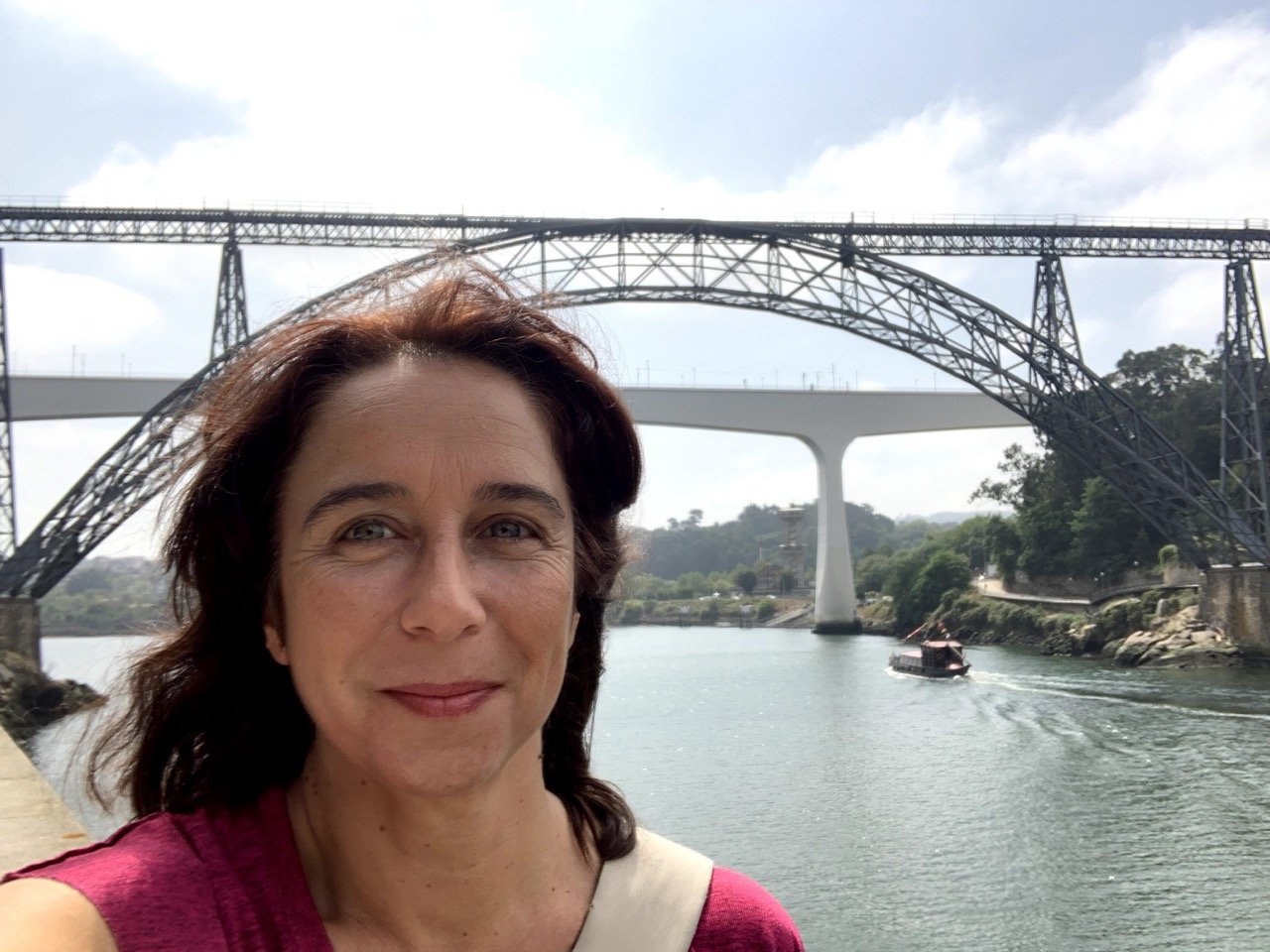
Connect with a local expert










